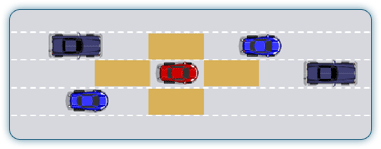How to Maintain a Space Cushion
 Space Cushions
Space Cushions
There are four space cushions to pay attention to: what’s ahead of you, what’s behind you, and what’s beside you on the left and on the right. Tailgaters (i.e., drivers who are following you way too closely) are a major cause of collisions. It’s important not to tailgate other drivers, because if the car in front of you stops or slows suddenly, you might not be able to avoid hitting it. If you find cars settling in beside you, make space by slowing down or speeding up if you can.
The zones around your vehicle are your responsibility. Maintaining space cushion control means you are aware of the zones around your vehicle and you keep them as open as possible.
Using the Space Cushion System
One way to maintain your space cushions is to use the space cushion system. The space cushion system includes five key strategies for defensive driving:
- Look far ahead and be alert to potential hazards. What’s going on in your path of travel 15, 20, and 30 seconds down the road? If you’re not actively looking around this area, you won’t be able to identify any potential hazards, and then you won’t be able to adequately prepare for them. If visibility is less than ideal, you'll need to reduce your speed in order to give yourself more time to react to hazards.
- Get the big picture. Driving involves more than paying attention to your immediate path of travel. See everything on both sides of the highway. Is the roadway ahead of you wet or slick? Is there an ambulance with its siren blaring coming up behind you? Remember, check your blind spots and your intended path of travel and be aware of what’s going on all around you at all times.
- Keep your eyes moving. Staring is a dangerous. For one thing, it narrows your field of view, meaning that you’re not alert to what’s going on around you. It can also lead to zoning out or inattention to the roadway and the driving task.
- Leave yourself a way out. When you stop at a red light or stop sign, leave plenty of space between you and the car in front of you. If the driver in the car behind you isn’t paying attention, you may need extra room to pull forward or to pull out of the way to avoid being rear-ended. Similarly, try to leave the space on your left and right side open so you can pull away in an emergency situation. Sometimes it may be quicker and safer to change lanes than to come to a complete stop. Always leave yourself space in case of an emergency.
- Make sure others see you. Keep your headlights on, even in the daytime, to make yourself more visible to other drivers. Use turn signals before turning, tap on your brakes in plenty of time before slowing down, and use your horn in emergency situations to alert other drivers of a potential collision. Don’t assume that other drivers are paying attention in the way they should be. Use extra precaution and take every opportunity you have to communicate as clearly as possible with other roadway users.
Using defensive driving strategies like the space cushion system will help keep you and those around you safe on the roadway.